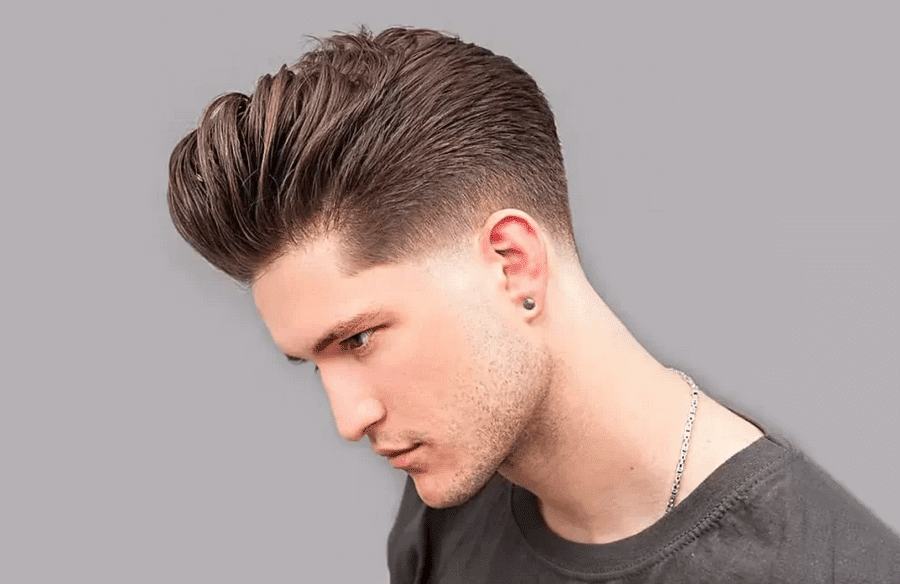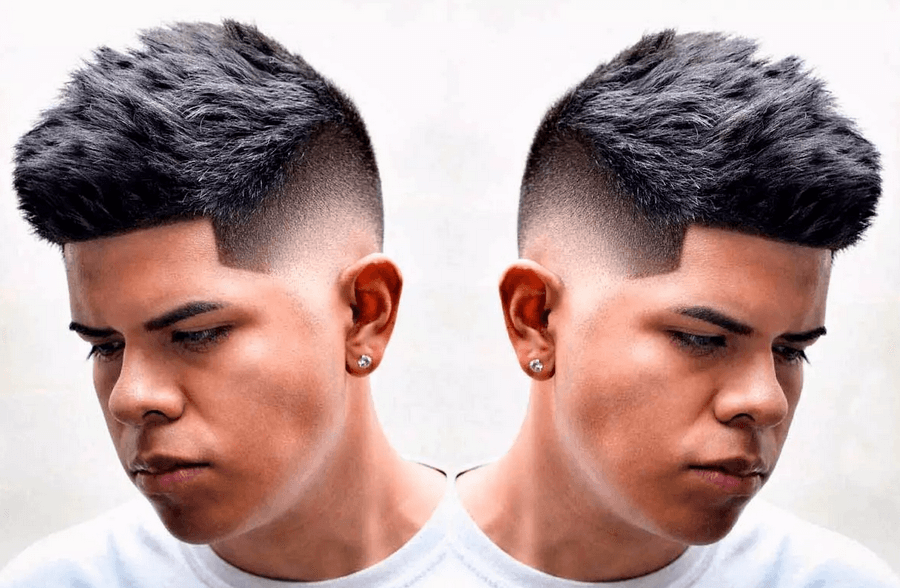📑Table of Contents:
The fade haircut is a timeless style that has evolved over the years. It remains a favorite due to its versatility and clean look. Whether you’re aiming for a classic or modern appearance, a fade can enhance your style. This blog post explores the different types of fade haircuts, how to achieve them, and tips for maintaining your fresh fade.

What is a Fade Haircut?
A fade haircut involves a seamless transition from short hair to longer hair. The hair gradually fades from one length to another, creating a smooth gradient effect. This style works well with various hair types and lengths, making it a versatile choice for many.
History and Evolution of the Fade
The fade haircut is a classic style with roots that can be traced back several decades, particularly to the mid-20th century. Over time, the fade has not only evolved in style but also in cultural significance, becoming a staple in men’s grooming around the world.
Origins of the Fade
The fade haircut originated in the United States during the 1940s and 1950s, primarily among military personnel. The military-inspired style was characterized by short hair on the sides and back that gradually faded into longer hair on top. The clean, sharp look was practical for soldiers, as it required minimal maintenance and adhered to strict grooming standards.
The style was initially popular among African American men, particularly during the 1960s and 1970s. Barbers in urban areas began experimenting with different fade techniques, creating variations that became popular in African American communities. The fade became a symbol of style and identity, especially within the context of the broader cultural and social movements of the time.
The Fade in the 1980s and 1990s
The 1980s saw the fade haircut gain mainstream popularity, particularly in the hip-hop community. Artists and entertainers like Will Smith, Tupac Shakur, and Big Daddy Kane sported fade haircuts, bringing the style to the forefront of popular culture. The introduction of the high-top fade, with a flat, boxy top and a sharp fade on the sides, became iconic during this era, symbolizing creativity and individuality.
In the 1990s, the fade continued to evolve, with more variations and personalized styles emerging. The fade became a versatile haircut that could be adapted to different textures and lengths of hair. The “bald fade” or “skin fade,” where the hair fades down to the skin, became especially popular, offering a sharper and more pronounced look.
The Modern-Day Fade
Today, the fade haircut remains a popular choice for men of all ages and backgrounds. It has transcended its military origins and cultural roots to become a universally recognized and versatile style. The modern fade can be customized in countless ways, from subtle and low fades to bold and high fades, making it suitable for various face shapes and personal styles.
Barbers continue to innovate with the fade, incorporating techniques like blending, tapering, and even adding designs or patterns into the fade itself. The style’s adaptability has contributed to its enduring popularity, as it can be combined with different hairstyles on top, such as pompadours, quiffs, or textured crops.
Cultural Significance
The faded haircut holds significant cultural importance, particularly within African American communities, where it is often seen as a symbol of self-expression and pride. Barbershops, where the fade is a staple service, have long been cultural hubs and social spaces, contributing to the community’s identity and cohesion.
Beyond its cultural roots, the fade haircut has become a global phenomenon, embraced by men of various ethnicities and backgrounds. Its widespread appeal lies in its clean, modern look and its ability to be tailored to individual preferences.
Types of Fade Haircuts
Fade haircuts come in several variations. Each type offers a unique look and can be tailored to suit individual preferences. Here are some of the most popular fade haircuts:
1. Low Fade
The low fade starts just above the ears and curves around the hairline. It’s a subtle and conservative style. The gradual transition makes it a great choice for those new to fade haircuts or preferring a less dramatic look.
2. Mid Fade
The mid fade, or medium fade, begins halfway up the sides of the head. It offers a balanced look, providing more contrast than a low fade. This style suits those who want a noticeable but not overpowering fade.
3. High Fade
The high fade starts high up on the head, around the temples. This bold and edgy style creates a stark contrast between the short and longer hair. It’s perfect for those looking to make a strong statement with their haircut.
4. Skin Fade
Also known as a bald fade, the skin fade involves fading the hair down to the skin. It can be low, mid, or high, depending on where the fade starts. This clean and sharp look is ideal for those who prefer a very short haircut.
5. Drop Fade
The drop fade curves down behind the ear, following the natural shape of the head. It creates a unique and stylish appearance. This variation adds a modern twist to the traditional fade haircut.
6. Burst Fade
The burst fade creates a circular fade around the ear, resembling a burst of hair. This style pairs well with mohawks and faux hawks, adding an extra dimension to the haircut.
How to Achieve a Fade Haircut

Achieving a perfect fade haircut requires skill and precision. While it’s best to visit a professional barber, understanding the basics can help you communicate your desired style. Here’s a step-by-step guide:
- Choose the Fade Type: Decide on the type of fade you want. Consider factors like your hair type, personal style, and how noticeable you want the fade to be.
- Start with Clean Hair: Wash your hair before getting a fade. Clean hair makes it easier to see the natural lines and ensures a smoother cut.
- Section the Hair: Use clips to section off the top part of your hair. This helps in maintaining a clear distinction between the faded sides and the longer top.
- Begin the Fade: Start with the longest guard on your clippers. Begin at the bottom of the hairline and work your way up. Gradually switch to shorter guards as you move higher, blending the lengths seamlessly.
- Blend the Hair: Use a comb and scissors to blend any harsh lines. The goal is to create a smooth transition from short to long hair.
- Detail the Edges: Clean up the edges and hairline using a trimmer. Sharp edges enhance the overall look and add a polished finish.
- Style the Top: Depending on your preference, style the top of your hair. You can leave it natural, add texture, or style it into a pompadour, quiff, or slick back.
Tips for Maintaining Your Fade Haircut
A fade haircut requires regular maintenance to keep it looking sharp. Here are some tips to help you maintain your fade:
- Regular Trims: Visit your barber every 2-3 weeks to maintain the fade. Regular trims keep the lines clean and prevent the hair from growing out unevenly.
- Moisturize Your Scalp: Keep your scalp moisturized to avoid dryness and irritation. Use a lightweight moisturizer or hair oil to maintain healthy skin.
- Avoid Over-Washing: Washing your hair too frequently can strip it of natural oils. Aim to wash your hair 2-3 times a week, using a mild shampoo and conditioner.
- Use the Right Products: Choose hair products that suit your hair type and style. Pomades, waxes, and gels can help in styling the top, while leave-in conditioners keep the hair soft and manageable.
- Protect Your Hair: If you spend a lot of time outdoors, protect your hair from sun damage. Wear a hat or use a hair product with UV protection to shield your hair from the sun’s harmful rays.
Trends in Fade Haircuts

Fade haircuts continue to evolve with new trends and styles emerging. Here are some current trends in fade haircuts:
- Textured Top with Fade: Adding texture to the top of the hair creates a dynamic contrast with the smooth fade. This style works well with both short and medium-length hair.
- Fade with Beard: Combining a fade haircut with a well-groomed beard creates a cohesive and stylish look. The fade can blend seamlessly into the beard, enhancing the overall appearance.
- Colored Fades: Experimenting with hair color adds a unique twist to the fade. Highlights, lowlights, or bold colors can make the fade stand out and reflect your personality.
- Patterned Fades: Adding patterns or designs to the fade creates a bold and artistic look. This trend is popular among those who want to make a statement with their haircut.
Wrap-up!
The fade haircut is a versatile and timeless style that suits various hair types and preferences. From low fades to high fades, each variation offers a unique look. Achieving and maintaining a fade requires skill and regular care. By understanding the different types of fades and following maintenance tips, you can keep your haircut looking sharp and stylish.
Whether you’re new to fade haircuts or looking to try a new variation, this guide provides everything you need to know. Embrace the fade haircut and enjoy a clean, modern, and versatile style that stands the test of time.





